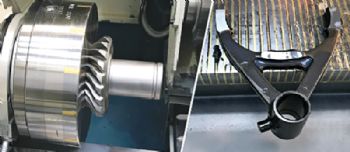
Xtrac provides a range of services to the motor-sport and automotive industries, specialising in the design, manufacture and build
of gearboxes and individual components for high-performance transmission systems and drive-
line components — all made in accordance with the ISO 9001:2008 certification.
The company has been in business for 33 years, and most of the world’s top motor-sport teams rely on its specialist expertise (90% of the components designed and manufactured by Xtrac are for the motor-sport industry).
Its gearboxes are key components in cars competing in Formula One, IndyCar, Le Mans and the World Rally Championship.
As the exclusive supplier of gearboxes to IndyCar, Xtrac has recently been awarded a multi-year extension that
continues its long-time position as the official supplier of transmissions for the Verizon IndyCar Series.
Xtrac uses a variety of magnetic work-holding devices from Sheffield-based Eclipse Magnetics Ltd (
www.eclipsemagnetics.com) when manufacturing gearboxes for the motor-sport industry.
Many of the components that make up the ‘gear clusters’ — including dog rings and selector forks — are machined on site at Xtrac’s 8,200m
2 purpose-built factory in Thatcham, Berkshire.
The components need to be held securely, while allowing appropriate access for machining processes that include turning, grinding and milling.
Every department at Xtrac uses some form of magnetic holding device, with the most commonly used being the ‘premium permanent magnetic chucks’, which are applied for medium- to heavy-duty turning applications.
Their circular design concentrates the entire magnetism from the chuck into the workpiece, thereby ensuring a high level of holding force.
Several types of radial-pole chucks are used for machining ‘dog rings’, as these provide the option of partial (variable) hold and can include through-bores and blanking plugs.
Furthermore, the chucks have thick metal top plates to ensure high accuracy and a long lifespan, as well as a high level of corrosion resistance (to resist damage from coolants).
Mark Rampton, a CNC grinding machine operator at Xtrac, said: “I’ve used these circular chucks for a number of years.
They are very versatile, minimise error and allow me to grind parts to high levels of flatness and accuracy — plus they are the most convenient way of keeping machined components in place.
"Without them, we would need special tooling. Dog rings can be quickly positioned and skimmed, with all sides machined to within 10µm.”
Dozens of magnetic chucks are used on a variety of machines at Xtrac, including a Matsuura 450 horizontal machining centre, a Matsuura R+ 500 vertical machining centre, several Studer grinding machines, a Jones and Shipman 1400X surface grinder — and various other grinding machines.
Eclipse Magnetics rectangular chucks are also used; these can be fixed to machine beds with clamps, and components such as selector forks can be positioned and held in place.
These chucks feature steel and brass laminations, along with high-performance neodymium magnets in the top plate for optimised performance.
Dave Lasenby, who operates manual grinding machines at Xtrac, says: “We find the manual rectangular chucks ideal for our work, as they provide a variable partial hold that allows particularly small or thin parts — such as selector forks — to be adjusted manually and any distortion due to the heat treatment process to be corrected.”